japanese garden timeline: 2012 to the present
2012: Cranbrook Center for Collections and Research (commonly known as the "Center") is founded. The Center's responsibilities, as reflected in its mission, include "sustaining and interpreting the Community's unparalleled landscape" as well as its "architecture, collections, and archives."
2012, June: Cranbrook Educational Community's Landscape Subcommittee considers a proposal to change the name of the garden from "Oriental Garden" to "Asian Garden." The decision is made to keep the name Oriental Garden, the name the Japanese Garden was given shortly before or after World War II.
2016, April 24: Dr. Kendall Brown of California State University, Long Beach, the foremost scholar and expert on North American Japanese-style gardens, delivers a lecture titled: "Cranbrook's Japanese Garden in Context: Japanese-Style Landscapes in America, Then and Now." Hosted by the Center for Collections and Research at Cranbrook Institute of Science, and sponsoed by the Japan America Society of Michigan and Southwestern Ontario, 186 members of the Cranbrook community and the general public attend the lecture. During his introduction, Center Director Gregory Wittkopp publicly announces the Center's "aspiration to revitalize that garden, including its iconic red Japanese moon bridge, and ensure the garden's future for the next generation." The next day, on Monday, April 25, Brown also leads a tour for Center staff and Subcommittee members through the Cranbrook Japanese Garden.
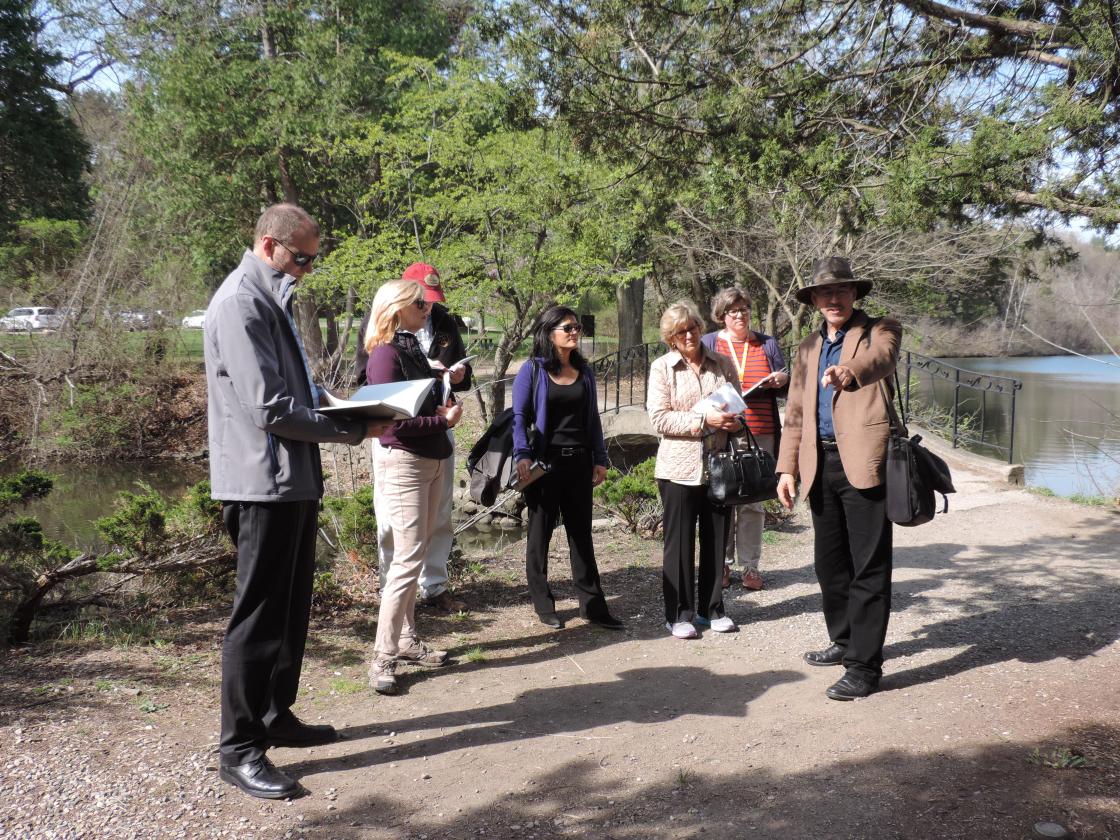
Kendall Brown (right) with the Japanese Garden Advisory Group, April 25, 2016. Photography by Thomas Booth.
2016, May 16: Following archival research into the Japanese Garden's naming history and, with support of the Center’s Subcommittee and the approval of the Board of Trustees Properties Committee, the name of the garden officially returns to the Japanese Garden from the Oriental Garden.
2016, June 16: The Board of Trustees of Cranbrook Educational Community adopts a new campus master plan, Toward Cranbrook 2030: One Vision, One Mission, One Plan, designed by Reed Hilderbrand of Cambridge, Massachusetts. Described as a “landscape framework plan,” the final section defines four Heritage Areas, including the Japanese Garden.
2016, Summer: The Center forms the Cranbrook Japanese Garden Advisory Group to lead the effort to rehabilitate the Japanese Garden. The original members, all of whom also serve as members of the Center Subcommittee, include Karen Hagenlocker (Advisory Group Chair), Thomas Booth, Leslie Li, Beth Lilley, Judy Lindstrom, Sandra Smith (Center Subcommittee Chair), and Center Director Gregory Wittkopp. The Advisory Group holds its first meeting on August 31, 2016.
2016, November 4: Members of the Japanese Garden Advisory Group, including Chair Karen Hagenlocker and Center Director Gregory Wittkopp, as well as Center Collections Fellow Kevin Adkisson, meet in New York City to tour the Japanese Hill and Pond Garden at the Brooklyn Botanic Garden (BBG). The day-long visit includes meetings with President Scot Medbury, Garden Curator Brian Funk, and Librarian Kathy Crosby. The Advisory Group agrees that a vermillion similar to the color of the BBG Torii Gate would be an appropriate color for the Japanese-style bridge in the Cranbrook Japanese Garden.
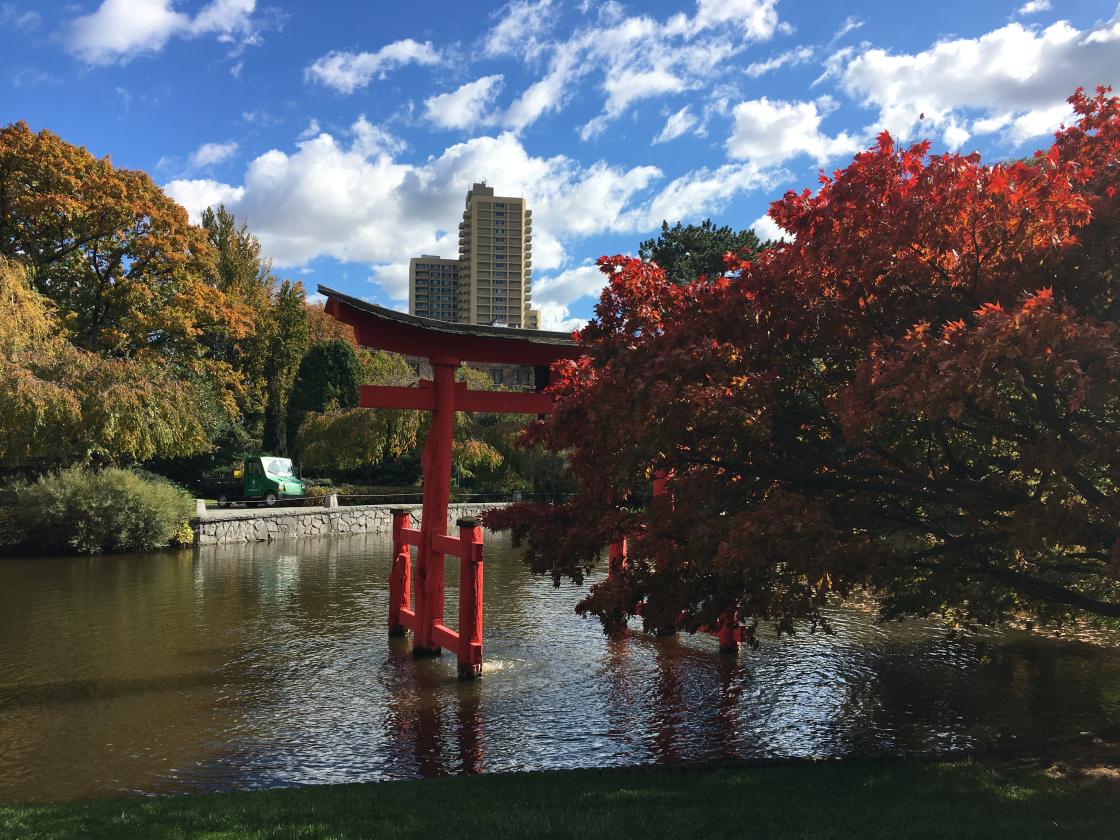
Torii Gate at Brooklyn Botanic Garden, November 4, 2016. Photography by Kevin Adkisson.
2016, December 10: Facilities craftsman Steve Trout reinstalls the Cranbrook Japanese Bridge after a three-month restoration and replacement. The railings of the original 1914 bridge were stripped of paint, rotten wood was removed and replaced, and the structure stabilized, while the chords (or beams) and treads were replaced with laminated redwood and redwood planks. The bridge is painted a striking vermillion (Benjamin Moore “Vermillion” Color Preview Line #2002-10) prior to its reinstallation.
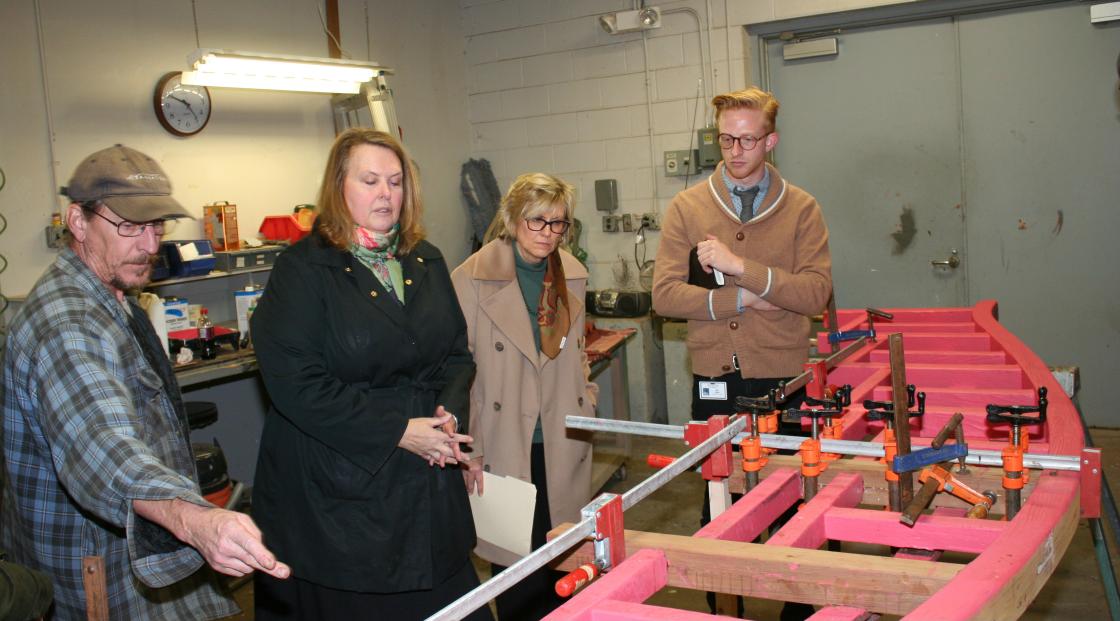
Steve Trout with the Japanese Garden Advisory Group, October 27, 2016. Photography by Thomas Booth.
2017, Summer: Cranbrook Center for Collections and Research commissions Quinn Evans Architects of Ann Arbor, Michigan, to research and write an Historic Landscape Study (HLS) for the Japanese Garden. With Preservation Landscape Architect Gregory W. De Vries, ASLA, taking the lead for Quinn Evans Architects, the study kicks off with a meeting at Cranbrook on August 31, 2017. De Vries submits the final study to the Center on January 30, 2018. The HLS includes a history and chronology of the garden, documentation of the existing landscape, and identification of character-defining features remaining from the Booth era.

Gregory De Vries, Karen Hagenlocker, and Gregory Wittkopp, August 31, 2017. Photography by Jin Kim.
2017, November 13: To support the Historic Landscape Study, the Michigan engineering and surveying firm Spalding DeDecker completes a detailed topographical survey of the Cranbrook Japanese Garden.
2018, May: The Center presents a four-evening “Japanese Garden Lecture Series” at Cranbrook Institute of Science. Speakers include Shinichiro Abe of ZEN Associates in Boston (May 1), Sadafumi Uchiyama of the Portland Japanese Garden in Oregon (May 15), Gregory De Vries of Quinn Evans Architects in Ann Arbor, Michigan (May 17), and Marc Peter Keane from Ithaca, New York (May 22). While De Vries’s lecture focuses exclusively on the Cranbrook Japanese Garden Historic Landscape Study, the lectures of the three Japanese garden designers look more broadly at the field of Japanese garden design through the gardens that each of them created or restored in North America. The lecture series is sponsored by Jeanne Graham, through the Clannad Foundation, and Karen Hagenlocker.
2018, May: As part of the “Japanese Garden Lecture Series,” the Cranbrook Japanese Garden Advisory Group meets informally in the Cranbrook Japanese Garden with Shinichiro Abe (May 1), Sadafumi Uchiyama (May 16), and Marc Peter Keane (May 23) to discuss their thoughts about rehabilitating the garden.
2018, May 4 – 5: The Center hosts a Two Days Away trip to Ohio that includes visits to the Japanese Garden at the Cleveland Botanical Center, where the garden’s designer David Slawson speaks with the participants, and the Japanese Garden on the grounds of Stan Hywet Hall in Akron. Participants include several members of the Japanese Garden Advisory Group including Chair Karen Hagenlocker, Beth Lilley, and Center Director Gregory Wittkopp.
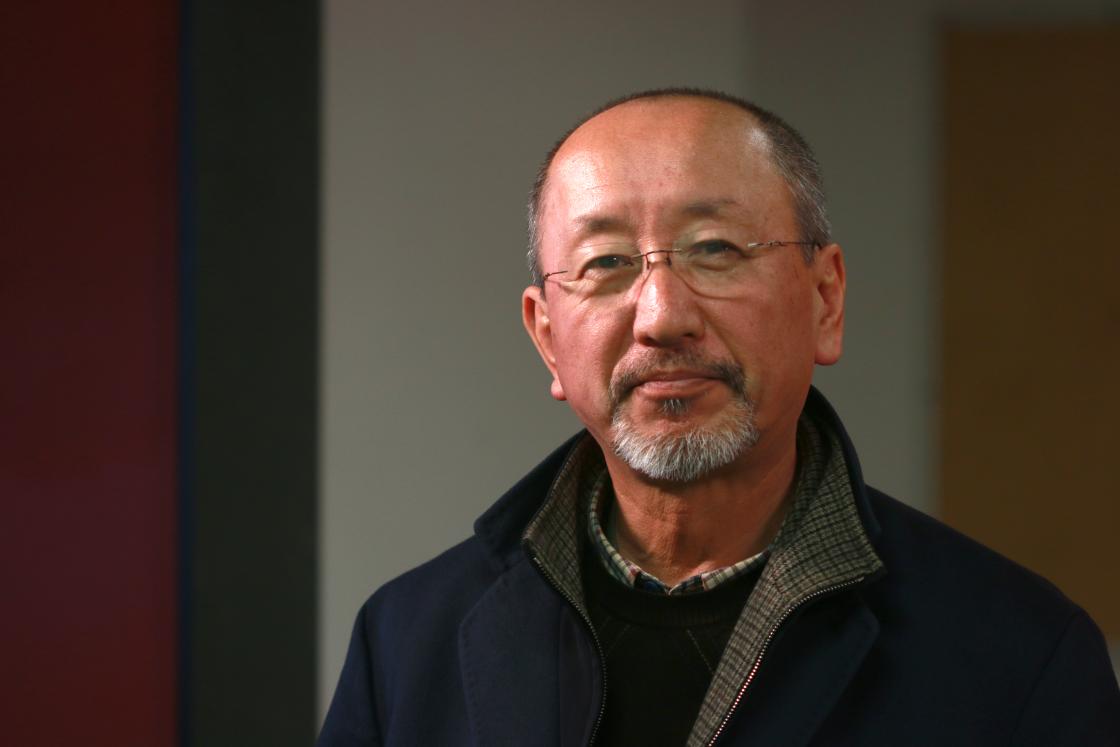
Shinichiro Abe. Courtesy of Shinichiro Abe.
2018, May 17 – 19: The Center hosts a three-day workshop for the North American Japanese Garden Association (NAJGA), “Creation and Rejuvenation: Six Japanese-Style Gardens in Michigan.” The workshop starts with a lecture on Thursday evening at Cranbrook Institute of Science by Gregory De Vries, which is part of the Center’s “Japanese Garden Lecture Series,” and is followed on Friday by tours of the Cranbrook Japanese Garden, the house and restored Asian-inspired garden at the Charles Lang Freer House in Detroit, and a lecture, tour, and reception at Minoru Yamasaki’s restored garden and pools surrounding the McGregor Memorial Conference Center at Wayne State University. The workshop continues on Saturday with visits to the Muelder Japanese Garden at Michigan State University, the Shigematsu Memorial Garden at Lansing Community College, and the new eight-acre DeVos Japanese Garden at Frederik Meijer Gardens and Sculpture Park in Grand Rapids. The workshop is hosted by Center Director Gregory Wittkopp and Kendall Brown of California State University, Long Beach.
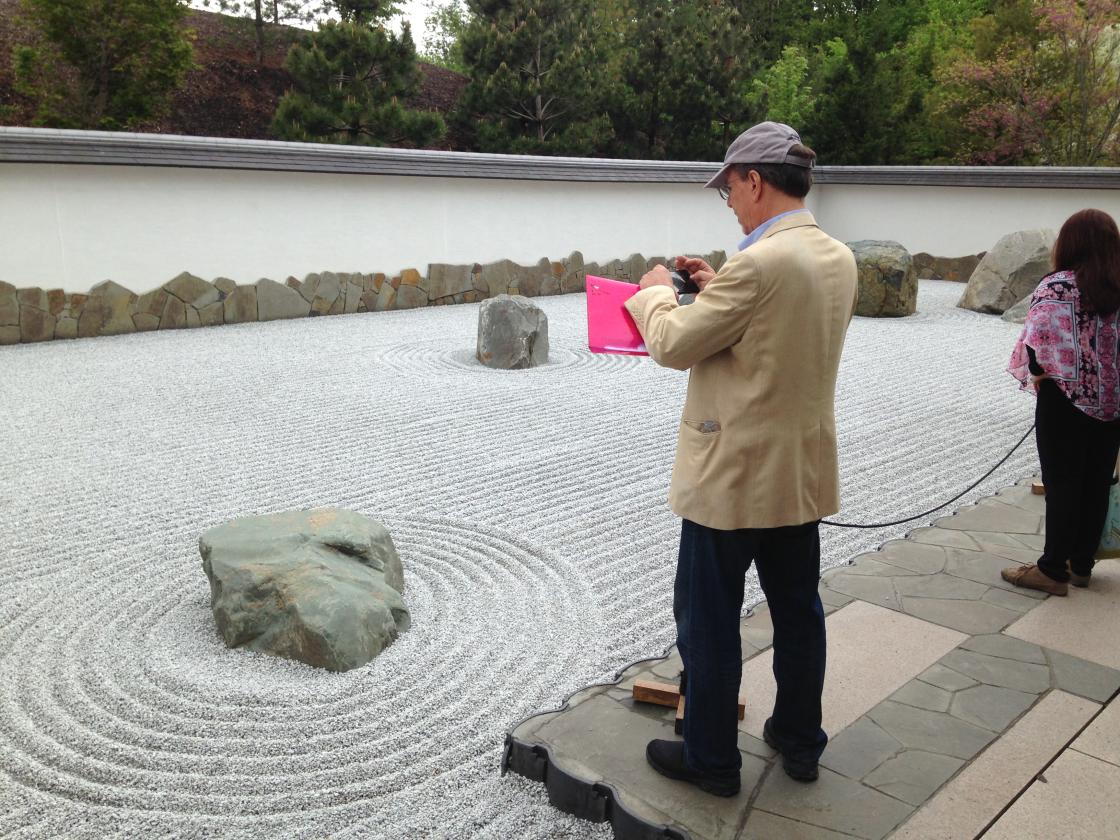
Kendall Brown Admires the Zen-style Garden in the DeVos Japanese Garden, May 19, 2018. Photography by Gregory Wittkopp.
2018, August 6: The Japanese Garden Advisory Group meets and discusses the criteria for the selection of a designer for a proposed master plan. The Group agrees that the designer will have 1) experience designing Japanese gardens of national significance; 2) experience working on the restoration and revitalization of an historic Japanese garden; 3) experience designing public gardens, including the inclusion of accessibility best practices; 4) recognition within the Japanese-American community; and 5) respect for the history and potential of the Cranbrook Japanese Garden. After reviewing the conversations that they had with several potential garden designers, the Advisory Group decides to ask Sadafumi Uchiyama, Garden Curator of the Portland Japanese Garden, to submit a proposal for the development of a master plan for the rehabilitation of the Cranbrook Japanese Garden.
2018, August 25: The Center presents the program “Japanese Tea Gardens and Tea Houses: From Japan to Frank Lloyd Wright and Today.” The program includes a lecture by Center Collections Fellow Kevin Adkisson, a karesansui demonstration by Japanese horticulturalist Chisato Takeuchi, which was sponsored by the Consulate-General of Japan in Detroit, and three chanoyu tea ceremonies by the Japan Society of Detroit Women’s Club in the Frank Lloyd Wright Smith House.
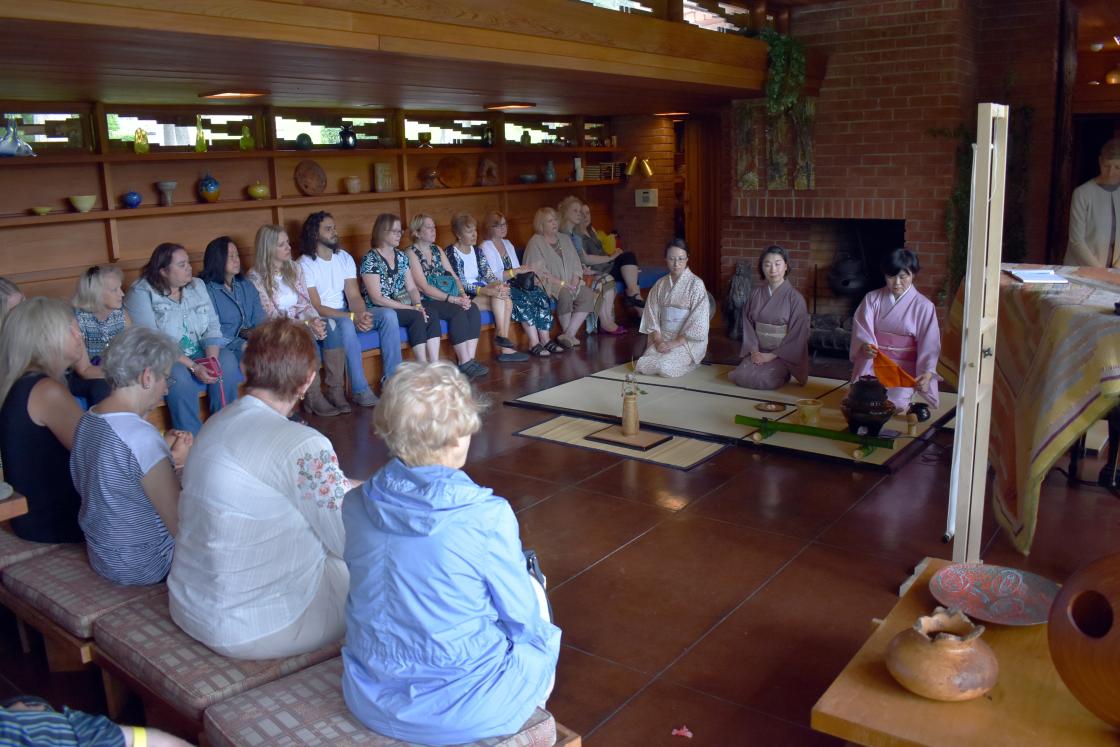
Japanese Tea Gardens and Tea Houses: From Japan to Frank Lloyd Wright and Today, August 2018. Photography by Kevin Adkisson.
2018, September 5: In the form of a letter to Center Director Gregory Wittkopp, Sadafumi Uchiyama submits a “Proposal for the Development of a Master Plan for Repairs and Improvements of the Japanese Garden at the Cranbrook.”
2018, September 13: The Japanese Garden Advisory Group interviews Sadafumi Uchiyama at Cranbrook and reviews with him the work he has done restoring and rehabilitating Japanese gardens in North America. This includes his ongoing work at the Osaka Garden, also called the Garden of the Phoenix, at Jackson Park in Chicago, which evolved from the Japanese garden originally created for the 1893 World’s Fair and Columbian Exposition. Following the meeting, Center Director Gregory Wittkopp contacts Uchiyama to let him know that the Advisory Group would be honored to have him design a master plan for the rehabilitation of the Cranbrook Japanese Garden.
2018, October 4 – 9: The Lily Pond Cascade is rehabilitated by Master Gardener Hiromu Terashita and five gardeners from the Japan Federation of Landscape Contractors. The project is funded, in part, by a grant from the Japanese Ministry of Land, Infrastructure, Transport and Tourism (MLIT), and supported by Consul General Mitsuhiro Wada and the Consulate-General of Japan in Detroit. The rehabilitated Lily Pond Cascade is formally dedicated on October 9 with a ribbon cutting ceremony conducted by Terashita and Center Patron Jeanne Graham. The dedication is followed by a celebratory dinner hosted by Consul General Wada.
2018, October 5: The Japanese Garden Advisory Group meets with Sadafumi Uchiyama at Cranbrook and discusses the master plan goals, design timeline, and strategies for its phased implementation.
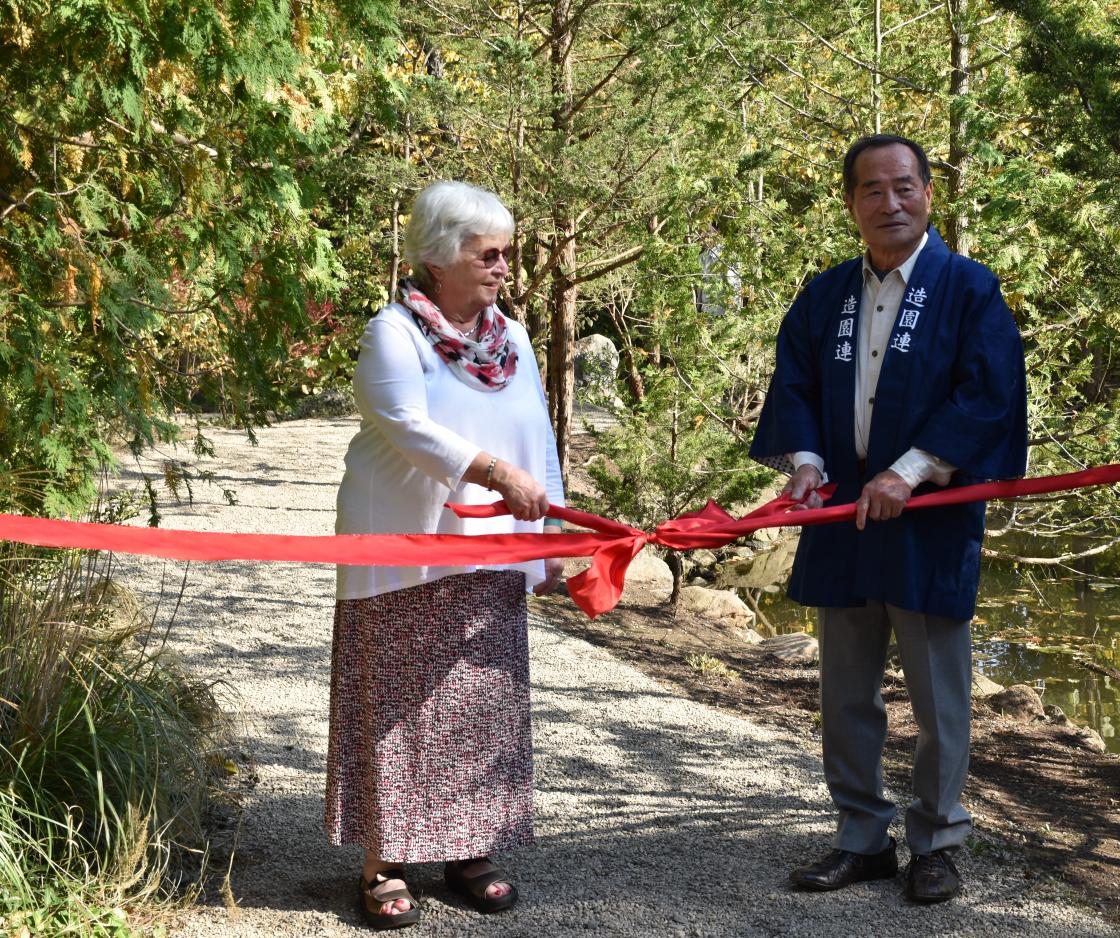
Ribbon Cutting by Jeanne Graham and Hiromu Terashita, October 9, 2018. Photography by Eric Franchy.
2018, October 6: The Center presents “Cranbrook Japanese Garden: A Day of Exploration," which features tours of the Lily Pond Cascade, as well as bonsai and ikebana displays and bonsai demonstrations in Cranbrook House. Partners include Jack Sustic, Former Curator, National Bonsai & Penjing Museum, Washington, D.C., and the Four Seasons Bonsai Club of Michigan.
2018, October 21: Sadafumi Uchiyama travels to Japan where he receives the highest award given by the Garden Society of Japan on the occasion of the Society’s 100th anniversary. The award, the “Jury Commendation/Exceptional Achievement” or Shinsa-in Tokubetsu-sho, recognizes Uchiyama’s designs for large-scale and commercial or public landscapes. Normally bestowed upon Japanese designers living and working in Japan, it is the first year a grand prize is awarded to a Japanese garden designer living and working outside the country.
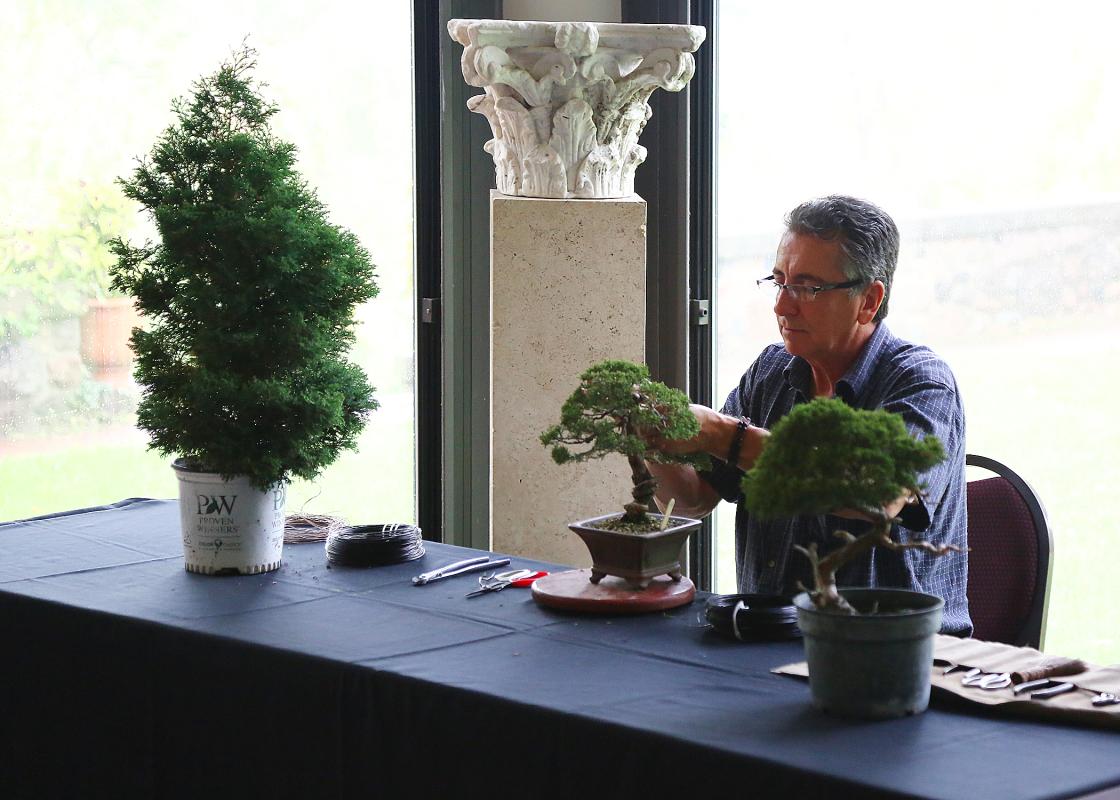
Bonsai demonstration by Jack Sustic, October 6, 2018. Photography by Jin Kim.
2018, October 22: Karen Hagenlocker, Chair of the Japanese Garden Advisory Group, discusses the Lily Pond Cascade rehabilitation project with the Board of Trustees Landscape Subcommittee. The Subcommittee reviews and supports the project and supports the retention of the new Yama-doro, the Mountain Lantern designed by master gardener Hiromu Terashita.
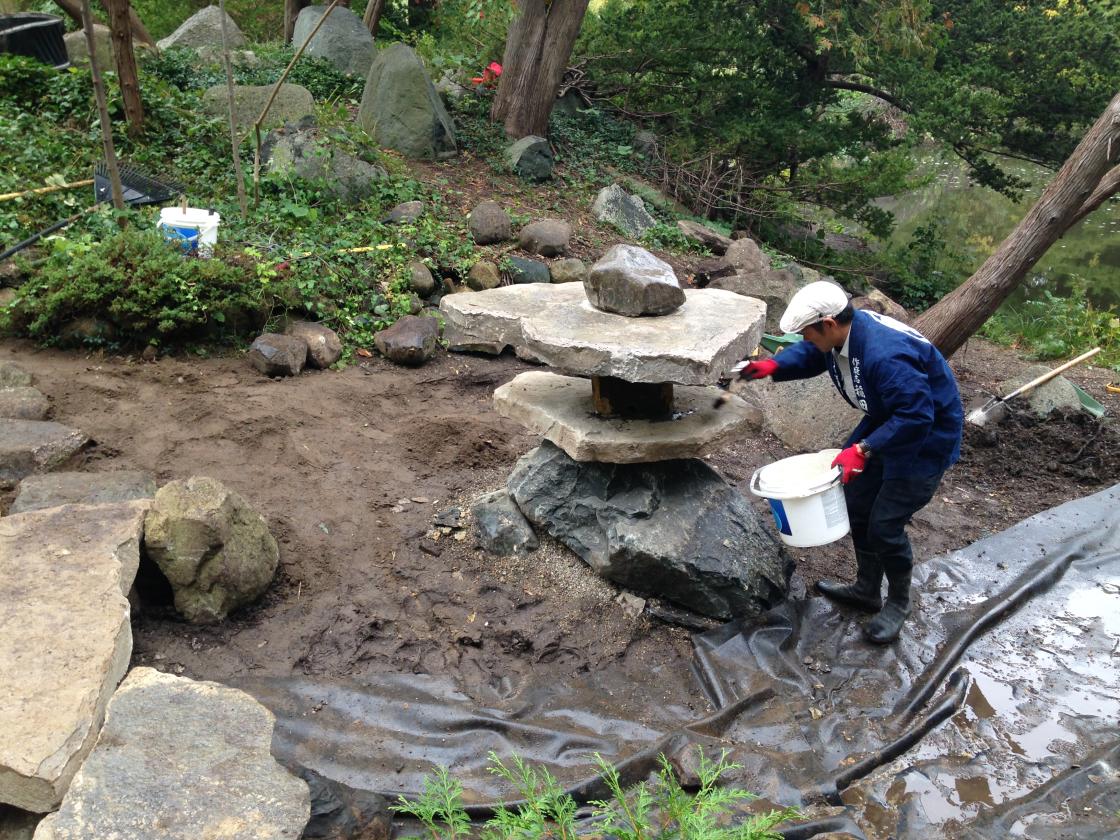
Hiroyoshi Inada Installs the Mountain Lantern, October 5, 2018. Photography by Gregory Wittkopp.
2019, January – July: Sadafumi Uchiyama works on his design for the master plan. He submits his Schematic Design to Cranbrook in March and discusses it with the Advisory Group during a conference call on March 27. Among other elements, the Advisory Group embraces Uchiyama’s desire to make as much of the garden as is possible barrier free and accessible to all visitors. Advisory Group Chair Karen Hagenlocker presents the Schematic Design to the Center Subcommittee on May 2 and the Landscape Subcommittee on May 3. Uchiyama completes more detailed drawings for the design of a new “Entrance Garden,” including a seating area, on April 28 and May 1. The Advisory Group reviews the design during a conference call May 9. Uchiyama’s draft of the design of the Master Plan, including a color drawing of the entire garden and perspective “image sketches” of key components, is completed on June 1. The draft is reviewed with the Advisory Group and Cranbrook leaders, including President Dominic DiMarco and Chief Operating Officer Rod Spearin, during Uchiyama’s visit to Cranbrook on June 11 and 12.
2019, May: Garden designer Emily Fronckowiak of Emaline Design, LLC, is hired by the Center to maintain the Cranbrook Japanese Garden during the 2019 growing season, focusing on the Lily Pond Cascade. Fronckowiak meets with Sadafumi Uchiyama in the garden on June 12 and again on October 13. Her work during the 2019 growing season includes removing invasive plants and pruning shrubs on Round Island and along the eastern edge of Lily Pond; placing stones between the Lily Pond Cascade and the Upper East Walk (to help prevent erosion); and supplementing the plantings surrounding the Lily Pond Cascade, especially along the east side.
2019, September 11: Jeanne Graham (1939 – 2019), dies at the age of eighty. Along with her husband, Ralph Graham (1931 – 2013), Jeanne Graham was a long-time champion and supporter of the Japanese Garden, including the primary sponsor of the of 2019 master plan by Sadafumi Uchiyama.

Emily Fronckowiak Working in the Japanese Garden, October 1, 2019. Photography by Gregory Wittkopp.
2019, October 13: Sadafumi Uchiyama returns to Cranbrook for the public unveiling of his completed proposed master plan. The Center’s program, “Cranbrook’s Japanese Garden: A Vision for the Future,” includes an overview of the history of the garden and the master plan project by Center Director Gregory Wittkopp, remarks by Consul General Tsutomu Nakagawa, Consulate General of Japan in Detroit, and a presentation of the proposed master plan by Uchiyama. The presentations at Cranbrook Institute of Science are followed by tours of the Japanese Garden, including one led by Uchiyama, and a private dinner at Cranbrook House. Dinner attendees include Guests of Honor Consul General Nakagawa, who was joined by Mrs. Nakagawa, and Uchiyama. Special guests include Ryuichi Wakisaka, Director of International Policy of Green Spaces Environment, Parks, Green Spaces and Landscape Division, Green Spaces Environment Office, Tokyo.

Consul General Nakagawa (left) and John Lord Booth, II (Center), with Sadafumi Uchiyama in Cranbrook’s Japanese Garden, October 13, 2019. Photography by Daniel Smith.
2019, October 30: Center Director Gregory Wittkopp presents Sadafumi Uchiyama’s master plan to Cranbrook Educational Community’s Board of Trustees Landscape Subcommittee, which is chaired by Judy Lindstrom who also is a member of the Center’s Japanese Garden Advisory Group. The Landscape Subcommittee reviews and supports the master plan and the Center’s request to research Uchiyama’s proposal for a “New Entrance Garden,” including the development of a budget and a funding plan.
2020, March, April, and May: The Center’s program “Four Traditional Japanese Arts Demonstrations” is scheduled to include wagashi, ikebana, and shodo demonstrations in Cranbrook House, as well three chanoyu tea ceremonies in the Frank Lloyd Wright-designed Smith House. The wagashi demonstration on March 3, which includes an introduction of houji-tea, is presented in collaboration with GEN-J: Grassroots Exchange Network Japan and the Michigan-Shiga Sister State Program.The ikebana and shodo demonstrations, as well the three chanoyu tea ceremonies are cancelled because of the onset of the novel coronavirus (COVID-19) pandemic.
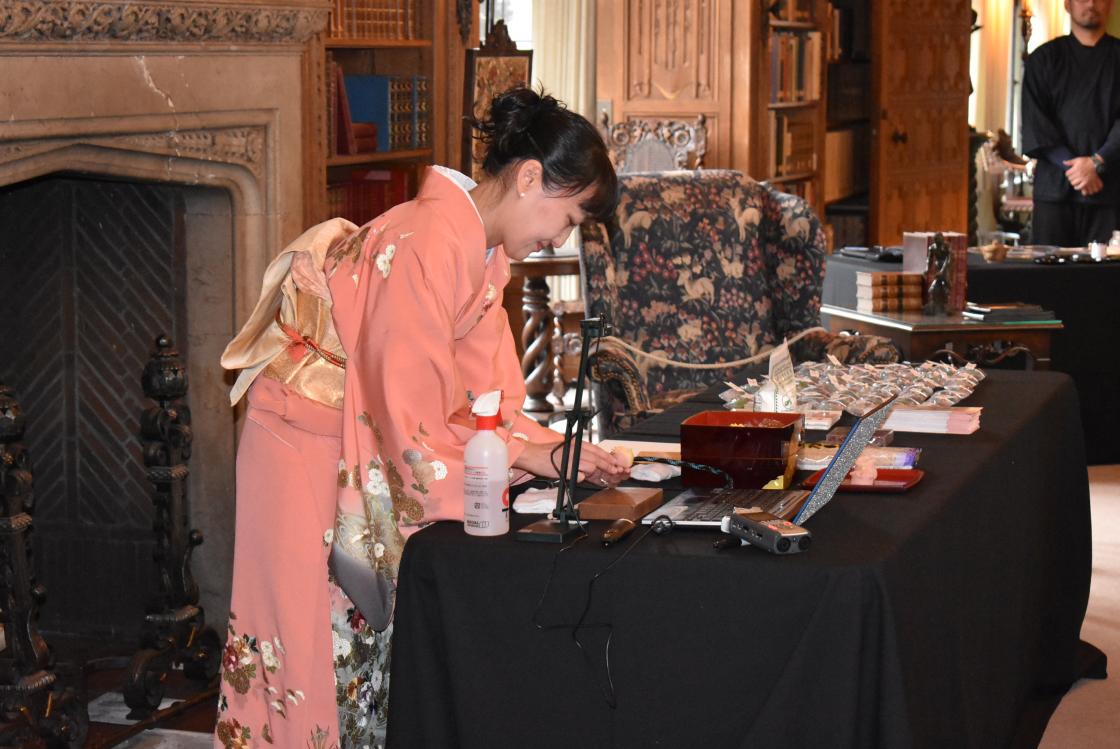
Wagashi Expert Toshiko Sugii Steffes in Cranbrook House Library, March 3, 2020. Photography by Leslie Mio.
2020, April and May: Sadafumi Uchiyama continues his work on the Cranbrook Japanese Garden Master Plan with additional designs for the “New Entrance Garden.” This work includes unique designs for a twenty-foot-long wooden bench on the South Landing overlooking the Japanese Kasuga Lantern and Lily Pond as well as two wooden bridges that would connect Round Island with both the South Landing and the Lower East Walk. He also submits a design for a gazebo that would overlook the “New Entrance Garden” as well as a design for a small bench that could be located on the south side of the East Water Gate/Dam along the historic Lakeside Walk.
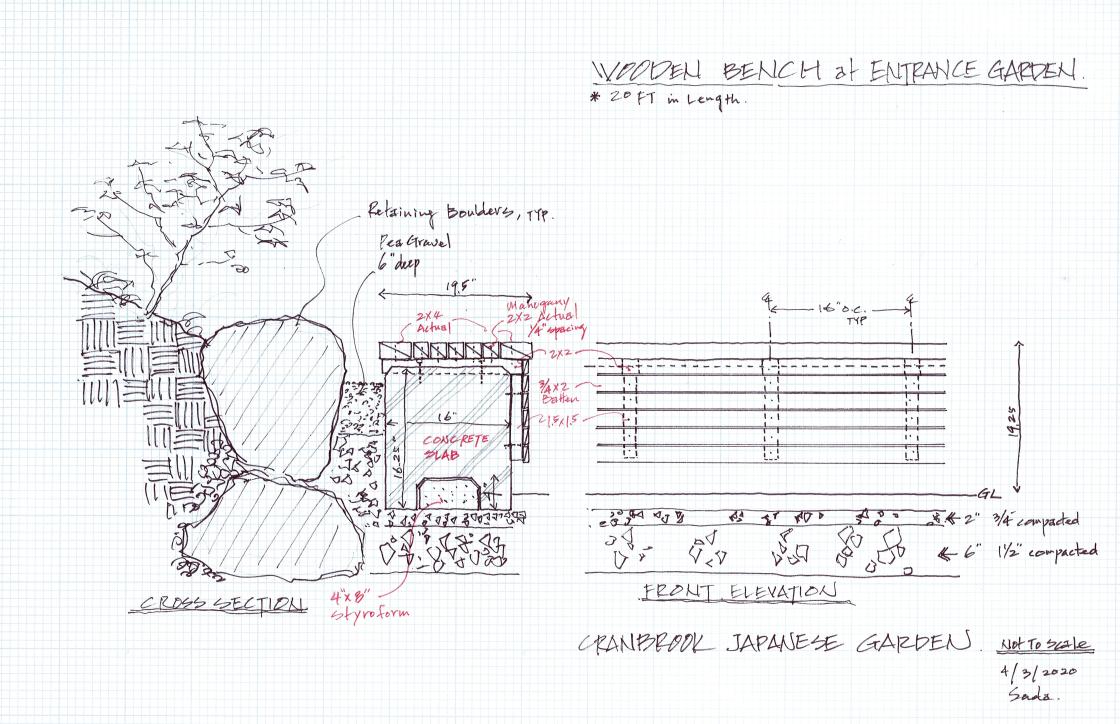
Sadafumi Uchiyama’s Design for the Bench in the New Entrance Garden, April 3, 2020. Drawing Courtesy Sadafumi Uchiyama.
2020, June: Garden designer Emily Fronckowiak of Emaline Design, LLC, is hired by the Center for the second year to maintain the Cranbrook Japanese Garden during the 2020 growing season. In addition to repairing damage to the Lily Pond Cascade, which occurred during an unusually heavy rainstorm in January, Fronckowiak’s work includes maintenance of Duck Island and the west side of the garden.
Gregory Wittkopp
Director
Cranbrook Center for Collections and Research
Updated August 2020
RELATED LINKS
Japanese Garden History
Japanese Garden Timeline: Early History to 2012
For more information on the Cranbrook Japanese Garden, including its history, rehabilitation, and programming, explore the Center for Collections and Research’s VISIT THE JAPANESE GARDEN website.
